This design standard gives typical examples for exchanger piping and horizontal and vertical reboiler data.
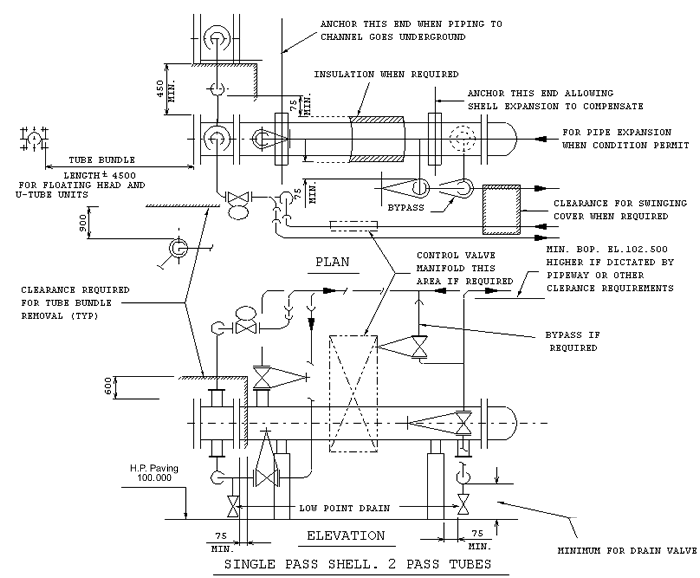
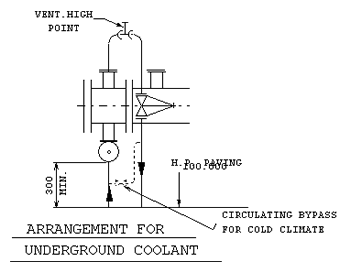
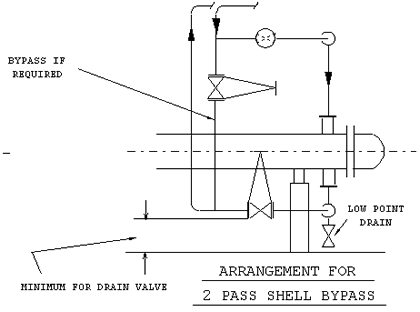
Example of cooler piping arrangement and clearances
|
Typical
Exchanger Arrangement |
Type
of Tube Bundle |
Construction Designation |
Typical use |
Possible alterations to typical arrangments without affecting thermal design (see note 1)
|
||||||
|
Interchange
Flow Media Note 4 |
Direction of Flow Change
|
Nozzle Relocation
|
||||||||
| Shell Side |
Tube Side |
Both Sides |
Note2 | Note3 | ||||||
|
1
|
|
Floating
Head |
Single Pass Shell Single Pass Tubes |
Exchanger
Cooler Heater |
*
|
-
|
-
|
V
|
V
|
V
|
|
2
|
|
Single Pass Shell |
*
|
V
|
V
|
V
|
-
|
V
|
||
|
3
|
|
Two Pass Shell Even Pass Tubes |
*
|
-
|
-
|
V
|
-
|
-
|
||
|
4
|
|
Divided Flow Shell Even Pass Tubes |
Condensor
Evaporator Reboiler |
-
|
-
|
V
|
-
|
-
|
-
|
|
|
5
|
|
Double Split Shell Even Pass Tubes |
-
|
-
|
V
|
-
|
-
|
-
|
||
|
6
|
|
U-Tubes
|
Single Pass Shell |
Exchanger Cooler
Heater (in clean tubes side service) |
*
|
V
|
V
|
V
|
-
|
V
|
|
7
|
|
Two Pass Shell Even Pass Tubes |
*
|
-
|
-
|
V
|
-
|
-
|
||
|
8
|
|
Kettle Type Reboiler |
Reboiler-steam
Generator-Vaporizer |
-
|
-
|
-
|
-
|
-
|
-
|
|
|
9
|
|
Fixed
Tubesheet |
Single Pass Shell Single or Odd Pass Tubes |
Exchanger Cooler |
*
|
-
|
-
|
V
|
V
|
V
|
|
10
|
|
Single Pass Shell Even Pass Tubes |
*
|
V
|
V
|
V
|
-
|
V
|
||
|
11
|
|
Double Pass Shell Even Pass Tubes |
*
|
-
|
-
|
V
|
-
|
-
|
||
Tabulation of typical exchangers and possible alterations for better piping
Notes typical exchangers:
- Alternaterations must be reviewed with exchanger engineer and/or process engineer
- Possible rotation of tube side nozzles 180 degree
- Possible rotation of shell side nozzles 180 degree
- May be considered only as a last resort since re-rating of exchanger would be required(*).
General Notes Mobile Servicing Equipment:
- Mobile servicing equipment (similar to that is shown) is generally used toe service exchangers
- Conditions that would preclude the use of this type of equipment are as follows
- Equipment location that, due to plot limitations and/or process requirements, do not permit acces of mobile equipment
- Equipment weights in excess of normal mobile maintenance equipment capacities
- Equipment elevated, too high for practical use of normal mobile maintenance equipment
- Additional servicing facilities (not shown) include:
- Gantry cranes
- Permanent structures with trolley beams and hoists
- Monorail system in building or structure
- Overhead frame on exchanger for troley hoist
- The design of exchanger associated piping includes proper consideration of maintenance requirements such as:
- Routing and supportin piping so that no temporary supports are required when removing channel and/or tube bundle or that, if necessary, temporary supports can be easiliy built
- Providing easily removable spool-pieces when required or routing piping to provide adequeate clearance for bundle removal or servicinb equipment. This necessitates a clear understanding of client clearance requirements and a knowledge of intended servicing equipment at the start of a project
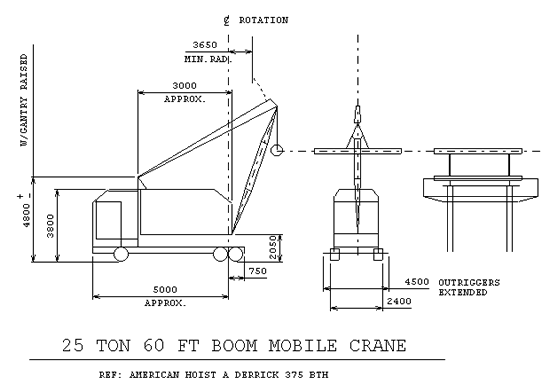
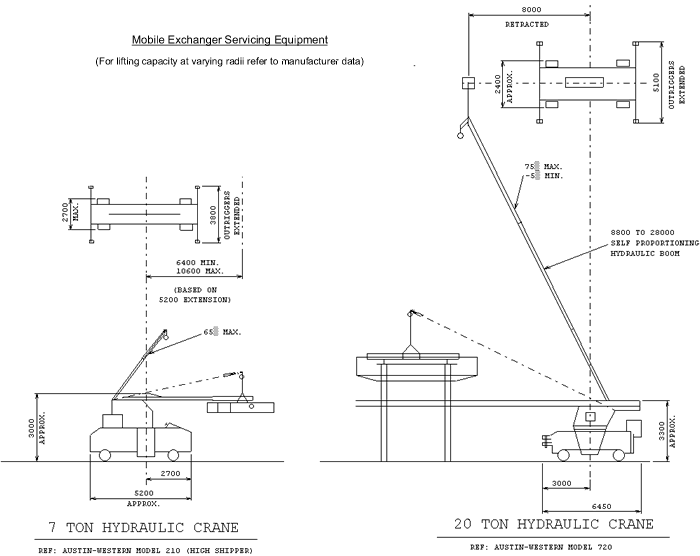
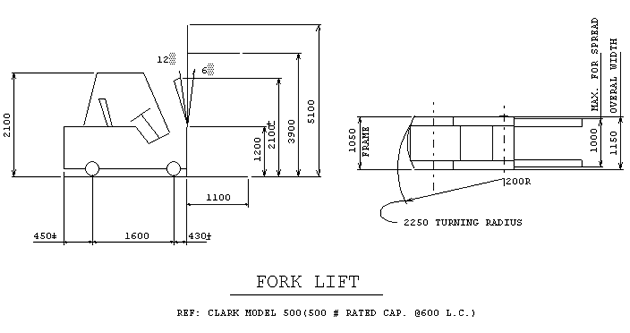
Terminolgy and typical functions of shell and tube heat exchangers
Exchanger heats one stream, cools the other
A physical change does not take place in the flowing media:
- Cooler - cools liquid or gasses without condensation (other designations: intercooler, aftercooler, condensor)
- Subcooler - condeses vapor and further cools the condensed
- Condensor - condenses vapor or vapor mixture
- Chiller - uses refrigerants for cooling process stream below prevailing water temperature
- Heater - heats process stream (other designation : preheater)
- Reboiler - reboil the bottom stream of the fractionation process
- Waste heat exchanger - uses waste heat (for example: process effluent gas or engine exhaust gas for steam generation)
- Steam generator - uses heat of process liquid or gas for producing steam
- Vaporizor - vaporizes part of a liquid stream (other designation: evaporator)
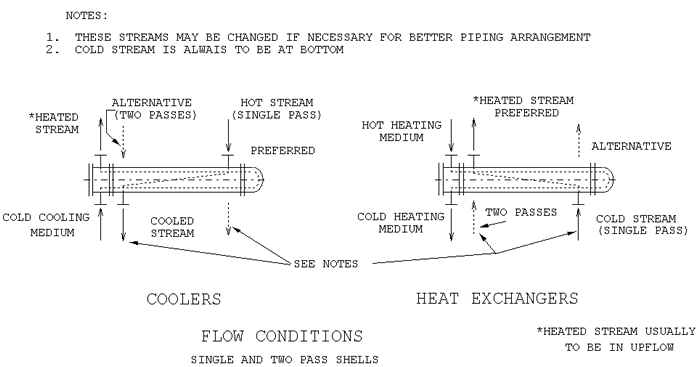
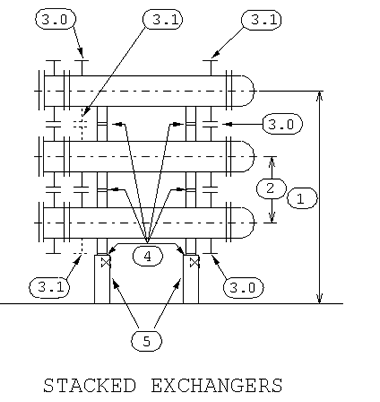
Stacked exchanger notes:
- Limited to 4 shells high in similar service and not to exceed a maximum elevation of 5500mm
- Nozzle and saddle protection shall be such as to allow space for shims between saddles
- Stacked exchangers in series flow and close coupled shall be arranged per vendor's design
- Alternate nozzle locations
- Slotted or oversize holes in one saddle
- Anchor location to be determined by piping configuration
- Angular, tangential or elbow nozzles may be used in series, parallel or dissimilar services
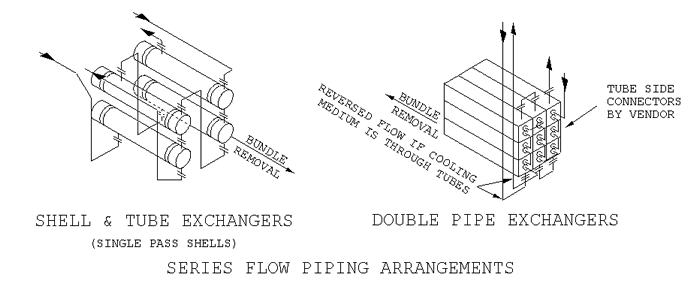
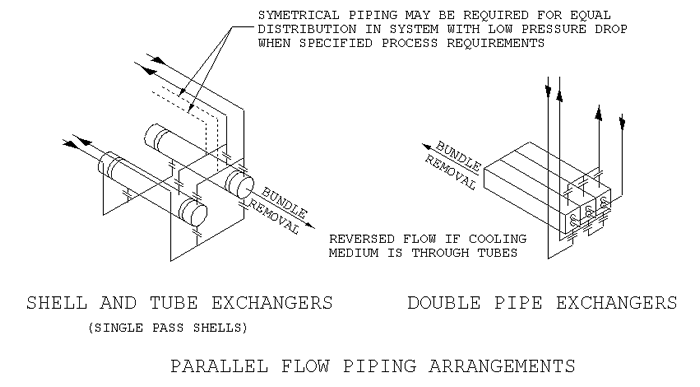
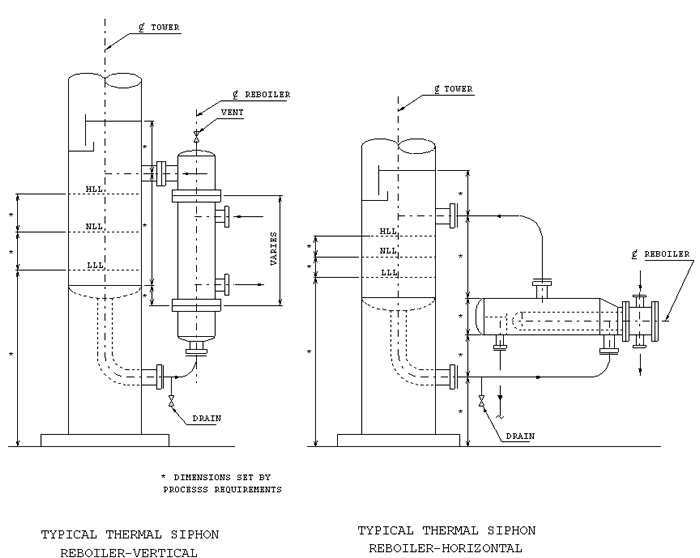
Reboiler notes:
- Horizontal reboilers shall be as close to the tower as practical with a minimum amount of pipe and elbows. The piping shall be stress analyzed as soon as the layout is firm. Support and anchor points shall be established at this time.
- The following information is required by the piping designer in order to layout thermal siphon reboilers:
- The elevation of the tower tangent line above grade
- The elevation of the first tray and the reboiler return line
- The length of the reboiler tubes and the type of outlet on the reboiler on the exchangers
- The dimension from the tangent line to the tubesheet on vertical exchangers and bottom of horizontal exchangers
- Most of this information is shown on the flow diagrams, vessel and reboiler specifications. The design shall review the layout with the process engineer to ensure that complete agreement is reached
- Avoid locating the reboiler return line under the downcomer. The top of the return line shall be a minimum of 12 inches below the bottom tray or 6 inches below the seal pan if the return line must be located under the downcomer.
- Allow sufficient room for removing tube bundles on vertical reboilers. Allow sufficient room to remove shell cover to grade.

